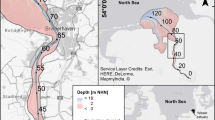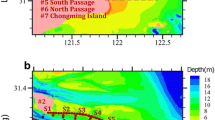Abstract
This study aims at gaining basic understanding about two specific phenomena that are observed in the highly turbid estuaries tidal Ouse, Yangtze and Ems, i.e. (1) the accumulation of suspended matter in the deeper parts of the estuaries and (2) the relatively high values of turbidity near the surface in the area of the turbidity maximum. A semi-analytical model is analysed to verify the hypothesis that these phenomena result from bottom slope-induced turbidity currents and from hindered settling, respectively. The model governs the dynamics of residual flow, driven by fresh water discharge, salinity gradients and turbidity gradients. It further uses the condition of morphodynamic equilibrium (no divergence of net sediment transport) to compute the residual sediment concentration. New aspects are that depth variations on flow and mixing processes, as well as flocculation and hindered settling of sediment, are explicitly accounted for. Tides act as a source of mixing and erosion of sediment only, thus processes like tidal pumping are not considered. Model results show that the estuarine turbidity maximum (ETM) shifts in the down-slope direction, compared to the case of a constant depth. Slope-induced turbidity currents, which are directed down-slope near the bottom and up-slope near the surface, are responsible for this shift, thereby confirming the first part of the hypothesis above. The down-slope shift of the ETM is reduced by currents resulting from gradients in depth-dependent mixing, which counteract turbidity currents, but which are always weaker. Including flocculation and hindered settling yields increased surface sediment concentrations in the area of the turbidity maximum, compared to the situation of a constant settling velocity, thereby supporting the second part of the hypothesis. Sensitivity experiments reveal that the conclusions are not sensitive to the values of the model parameters.








Similar content being viewed by others
References
Allen GP, Salomon JC, Bassoullet P, Du Penhoat Y, De Grandpre C (1980) Effects of tides on mixing and suspended sediment transport in macrotidal estuaries. Sediment Geol 26(1–3):69–90
Bowden KF, Fairbairn LA (1952) A determination of the frictional forces in a tidal current. Proc R Soc Lond, A Math Phys Sci 214(1118):371–92
Brenon I, Le Hir P (1999) Modelling the turbidity maximum in the Seine estuary (France): identification of formation processes. Estuar, Coast Shelf Sci 49(4):525–544
Burchard H, Craig PD, Gemmrich JR, van Haren H, Mathieu PP, Meier HEM, Smith W, Prandke H, Rippeth TP, Skyllingstad ED, Smyth WD, Welsh DJS, Wijesekera HW (2008) Observational and numerical modeling methods for quantifying coastal ocean turbulence and mixing. Prog Oceanogr 76(4):399–442
Burchard H, Hetland RD, Schultz E, Schuttelaars HM (2011) Drivers of residual estuarine circulation in tidally energetic estuaries: straight and irrotational channels with parabolic cross section. J Phys Oceanogr 41: 548–570. doi:10.1175/2010JPO4453.1
Chernetsky AS, Schuttelaars HM, Talke SA (2010) The effect of tidal asymmetry and temporal settling lag on sediment trapping in tidal estuaries. Ocean Dyn 60(5):1219–1241
Festa JF, Hansen DV (1978) Turbidity maxima in partially mixed estuaries: a two-dimensional numerical model. Estuar Coast Mar Sci 7:347–359
Friedrichs CT, Hamrick JH (1996) Effects of channel geometry on cross sectional variation in along channel in partially stratified estuaries. In: Aubrey DG, Friedrichs CT (eds) Buoyancy effects on coastal and estuarine dynamics, vol 53. American Geophysical Union, pp 283–300
Friedrichs CT, Armbrust BD, De Swart HE (1998) Hydrodynamics and equilibrium sediment dynamics of shallow, funnel-shaped tidal estuaries. In: Dronkers J, Scheffers MBAM (eds) Physics of estuaries and coastal seas. Balkema, Rotterdam, pp 315–327
Groen P (1967) On the residual transport of suspended matter by an alternating tidal current. Neth J Sea Res 3(4):564–574
Hansen DV, Rattray M (1965) Gravitational circulation in straits and estuaries. J Mar Res 23:104–122
Huijts KMH, de Swart HE, Schramkowski GP, Schuttelaars HM (2011) Transverse structure of tidal and residual flow and sediment concentration in estuaries. Ocean Dyn 61(8): 1067–1091. doi:10.1007/s10236-011-0414-7
Jay DA, Musiak JD (1994) Particle trapping in estuarine tidal flows. J Geophys Res 99:445–461
Jiang C, Li J, de Swart, H E (2012) Effects of navigational works on morphological changes in the bar area of the Yangtze Estuary. Geomorphology 139–140: 205–219. doi:j.geomorph.2011.10.020
de Jonge VN (2000) Importance of temporal and spatial scales in applying biological and physical process knowledge in coastal management, an example for the Ems estuary. Cont Shelf Res 20:1655–1686
Lerczak JA, Geyer WR (2004) Modeling the lateral circulation in straight, stratified estuaries. J Phys Oceanogr 34(6):1410–1428
Lin J, Kuo AY (2001) Secondary turbidity maximum in a partially mixed microtidal estuary. Estuaries 24(5):707–720
Lin J, Xie L, Pietrafesa LJ, Shen J, Mallin MA, Durako MJ (2006) Dissolved oxygen stratification in two micro-tidal partially-mixed estuaries. Estuar, Coast Shelf Sci 70:423–437
Liu G, Zhu J, Wang Y, Wu H, Wu J (2011) Tripod measured residual currents and sediment flux: impacts on the silting of the deepwater navigation channel in the Changjiang estuary. Estuar, Coast Shelf Sci 93(3):192–201
Mehta AJ (1984) Characterization of cohesive sediment properties and transport processes in estuaries. In: Mehta AJ (ed) Lecture notes on coastal and estuarine studies, vol 14. Springer-Verlag, pp 290–325
Mitchell S, Lawler D, West J, Couperthwaite J (2003) Use of continuous turbidity sensor in the prediction of fine sediment transport in the turbidity maximum of the Trent estuary, UK. Estuar, Coast Shelf Sci 58(3):645–652
Murray AB (2003) Contrasting the goals, strategies, and predictions associated with simplified numerical models and detailed simulations. In: Wilcock PR, Iverson RM(eds) Prediction in Geomorphology, Geophysical Monograph, vol 135. American Geophysical Union, pp 151–168. doi:10.1029/135GM11
Postma H (1954) Hydrography of the Dutch Wadden Sea. Arch Neerl Zool 10(4): 405–511. doi:10.1163/036551654X00087
Postma H (1961) Transport and accumulation of suspended matter in the Dutch Wadden Sea. Neth J Sea Res 1: 148–190. doi:10.1016/0077-7579(61)90004-7
Postma H (1967) Sediment transport and sedimentation in the estuarine environment. Estuaries 83:158–179
Schoellhamer DH (2001) Influence of salinity, bottom topography, and tides on locations of estuarine turbidity maxima in northern San Francisco Bay. IEP-Newsl 14:54–61
Schramkowski GP, de Swart HE (2002) Morphodynamic equilibrium in straight tidal channels: combined effects of Coriolis force and external overtides. J Geophys Res 107(C12):3227–3245
Scully ME, Friedrichs CT (2003) The influence of asymmetries in overlying stratification on near-bed turbulence and sediment suspension in a partially mixed estuary. Ocean Dyn 53(3):208–219
Scully ME, Geyer WR, Lerczak JA (2009) The influence of lateral advection on the residual estuarine circulation: a numerical modeling study of the Hudson River estuary. J Phys Oceanogr 39(1):107–124
Stacey MT, Brennan ML, Burau JR, Monismith SG (2010) The tidally averaged momentum balance in a partially and periodically stratified estuary. J Phys Oceanogr 40: 2418–2434. doi:10.1175/2010JPO4389.1
Talke SA, de Swart, HE, Schuttelaars HM (2009a) An analytical model of the equilibrium distribution of suspended sediment in an estuary. Cont Shelf Res 29(1): 119–135. doi:10.1016/j.csr.2007.09.002
Talke SA, De Swart HE, De Jonge VN (2009b) An idealized model and systematic process study of oxygen depletion in highly turbid estuaries. Estuaries 32(4):602–620
Uncles RJ, Easton AE, Griffiths ML, Harris C, Howland RJM, King RS, Morris AW, Plummer DH (1999) Seasonality of the turbidity maximum in the Humber-Ouse estuary, UK. Mar Pollut Bull 37(3–7):206–215
Uncles RJ, Stephens JA, Smith RE (2002) The dependence of estuarine turbidity on tidal intrusion length, tidal range and residence time. Cont Shelf Res 22(11–13):1835–1856
Uncles RJ, Stephens JA, Harris C (2006) Runoff and tidal influences on the estuarine turbidity maximum of a highly turbid system: the upper Humber and Ouse Estuary, UK. Mar Geol 235(1–4):213–228
Warner JC, Geyer WR, Lerczak JA (2005) Numerical modeling of an estuary: a comprehensive skill assessment. J Geophys Res 110: 691. doi:C05001:10.1029/2004JC002
Winterwerp JC (2002) On the flocculation and settling velocity of estuarine mud. Cont Shelf Res 22(9):1339–1360
Winterwerp JC (2011) Fine sediment transport by tidal asymmetry in the high-concentrated Ems River: indications for a regime shift in response to channel deepening. Ocean Dyn 61(2): 203–212. doi:10.1007/s10236-010-0332-0
Wright LD, Friedrichs CT, Kim SC, Scully ME (2001) Effects of ambient currents and waves on gravity-driven sediment transport on continental shelves. Mar Geol 175:25–45
Wurpts RW, Torn P (2005) 15 years experience with fluid mud: definition of the nautical bottom with rheological parameters. Terra et Aqua 99:22–32
Acknowledgments
We thank S.A. Talke, R. Uncles and C. Jiang for providing data of the Ems, tidal Ouse and Yangtze. Part of the work of the first author was funded by the Dutch Waddenfonds and the Dutch Ministry of Public Works. We thank Carl Friedrichs and three anonymous reviewers for their comments and suggestions which improved our paper.
Author information
Authors and Affiliations
Corresponding author
Additional information
Responsible Editor: Emil Vassilev Stanev
Appendix: Expressions
Appendix: Expressions
Description of the model parameters values for the model. All model parameters are functions of the scaled vertical coordinate ζ, the Péclet number Pe v depends on horizontal coordinate x (see Eq. (16)) and the scaled depth \(\tilde{h}\) which is defined as h(x)/H.
in which
in which
Rights and permissions
About this article
Cite this article
Donker, J.J.A., de Swart, H.E. Effects of bottom slope, flocculation and hindered settling on the coupled dynamics of currents and suspended sediment in highly turbid estuaries, a simple model. Ocean Dynamics 63, 311–327 (2013). https://doi.org/10.1007/s10236-013-0593-5
Received:
Accepted:
Published:
Issue Date:
DOI: https://doi.org/10.1007/s10236-013-0593-5




